Premiering in the final issue of Amazing Fantasy (#15, Aug. 1962) before anchoring his own solo line The Amazing Spider-Man (March 1963), Spider-Man has long been the poster boy and franchise character for Marvel Comics. He’s the character you could relate to, escaping into the fantastical world of mad scientists and insane villains flying around on gliders while also relating to a main character who has to worry about paying the rent, holding down a job, being there for his friends and family, and enduring constant romantic heartbreak. He’s also the star of 5 theatrical films which have grossed a combined $3.2 billion worldwide since 2002. In fact, the popularity of his films (and many, many, many animated shows over the years) might obscure his actual comic book history.
So, while we in the States await the release of The Amazing Spider-Man 2 let’s go way back to the beginning and look at some notable as well as lesser-known elements of Spidey’s 52 year comic book history:
1. We still don’t for sure who actually created Spider-Man
The problem with Stan Lee’s story about how he created Spider-Man is that by his own admission he’s told the story so often not even he knows if it’s true anymore. The actual origins for Spider-Man likely go back over a decade earlier, and don’t involve Stan Lee at all. Joe Simon and Jack Kirby had created Captain America together for Timely Comics (eventually renamed Marvel) in 1940, but by 1959 they had split up as partners, Simon going to work in advertising and Kirby catching on with DC Comics. Then Archie Comics approached Simon about creating a new superhero for them since DC was having success reviving all of its old superheroes. Simon enlisted his old partner’s help, and they revisited an old idea of their’s about a young orphaned boy living with an old couple. He wishes upon a ring he finds in a magical spider web, and is transformed into the adult superhero Silver Spider, fighting crime with a gun which shoots webs. Kirby nixed the name Silver Spider, suggesting Spider-Man instead, which they briefly ran with before ultimately re-working and re-naming the character The Fly.
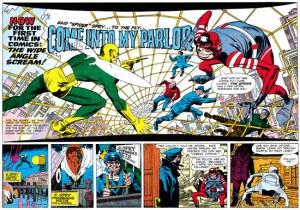
From Simon/Kirby’s first issue of The Fly. It only ran for 30 issues.
By 1962, Stan Lee, who’d been with Marvel since its Timely days in the early 1940s, was now Editor-in-Chief, and Jack Kirby his go-to artist. Stan Lee wanted a teenage superhero, cutting out the middle man of the DC model and just dropping the adult hero and making the sidekick the main character, but who actually created the character?

forbiddenplanet.co.uk
The version that seems to have the most validity is that Lee approached Kirby to help come up with a teenage superhero. Kirby pitched him the version of the Silver Spider he and Simon had co-created before adapting it into the Fly. Lee liked it enough to request some art-work, but Kirby delivered something which looked far too much like a re-worked Captain America. So, Lee gave the project to Steve Ditko, who immediately noticed the similarities between Kirby’s proposal and The Fly. As a result, Lee allowed Ditko to change things up. He dropped the web gun and whole magic ring premise, and threw out Kirby’s original design for the costume, instead creating from scratch the now-beloved and iconic Spider-Man costume.
Both Lee and Ditcko agreed that Lee thought up the name Spider-Man while Kirby maintained he did (only for Simon to later disagree and argue that actually way back when they created the Silver Spider together it was he, not Kirby, who created the name Spider-Man). Lee is probably who thought of having Spider-Man get his powers from a radioactive spider bite instead of a magic ring, but not even that is known for sure.
2. Uncle Ben never actually said “With great power, comes great responsibility”
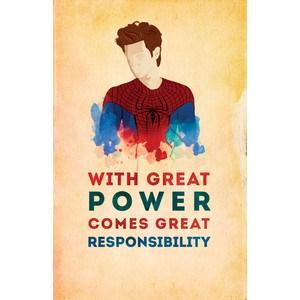
No comic book character has a more perfect summation of their moral code and overall message than Spider-Man’s legendary, “With great power, comes great responsibility.” Although similar to quotes from famous historical figures like Winston Churchill, and Franklin and Theodore Roosevelt, no one appears to have put it quite that way until Stan Lee thought it up for Spider-Man’s inaugural appearance in Amazing Fantasy #15 (1962).
In the Spider-Man story, this quote has always been attributed to Uncle Ben, making it all the more profound of a proclamation coming from the man who died precisely because Peter Parker misused his powers and didn’t stop a crime when he easily could have. In the Sam Raimi film Uncle Ben says it directly to Peter shortly before his death, and the comics Peter have retroactively attributed the quote to Ben. The problem is Uncle Ben is not the one who actually says it in Amazing Fantasy #15. In fact, no specific character actually utters those lines. Instead, after Parker has delivered Ben’s killer to the police the caption box commenting on the action reads, “And a lean, silent figure slowly fades into the gathering darkness, aware at last that in this world, with great power must also come–great responsibility!”
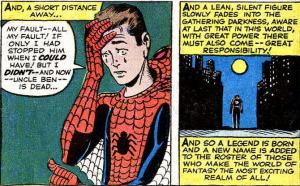
3. Steve Ditko wouldn’t speak to Stan Lee even though they were working on Amazing Spider-Man together
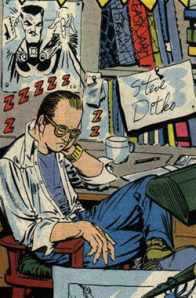
Although the who, what, and when of the actual conception of the Spider-Man character will likely never be entirely clear, what is certain is that Stan Lee (as the writer) and Steve Ditko (as the artist) worked together on Amazing Fantasy #15 and The Amazing Spider-Man #1-#38. The only outside party was Jack Kirby who designed the covers for Amazing Fantasy #15 and Amazing Spider-Man #1. Otherwise, it was just Lee and Ditko, and during their run together most every notable Spider-Man supporting character and villain was introduced, including Doctor Octopus, Green Goblin, Electro, Lizard, Sandman, Aunt May, Betty Brant, Gwen Stacy, Mary Jane Watson (though her actual face was only revealed after Ditko left), Harry Osborn, Flash Thompson, and J. Jonah Jameson.
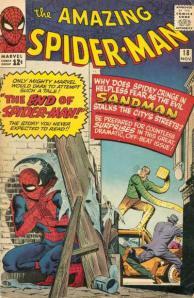
However, Lee and Ditko absolutely did not get along. By the time Amazing Spider-Man #18 arrived in Nov. 1963, Ditko was taking control of the story lines. Normally, Lee would create a plot outline which Ditko was then to animate and greatly embellish, and once Ditko was done with the art Lee would fill in the voice boxes and captions with text. Now, Ditko was creating his own plots, and ignoring Lee’s commands to maximize the number of costumed fights, soften the supporting characters, and introduce as many fantastic or mystical elements as possible. #18 was the first one Ditko plotted entirely on his own, and it led Lee to quip in a print ad that fans were sure to hate it so everyone should rush out to buy it to see what all the fuss was about.
Shortly thereafter, Ditko went to Marvel with two requests: 1) To be credited and paid as co-writer since he was doing his own plots now; 2) To not have to speak Stan Lee ever again. The book was selling so well they couldn’t turn him down.
Lee got him back by putting Ditko’s name first on one of the Amazing Spider-Man covers but then putting his own name below it at twice the size. Plus, he had Spider-Man begin to guest star in the pages of Daredevil as a test run to see how that book’s artist, John Romita, would handle Spider-Man should things fall apart with Ditko. Which is exactly what happened when Ditko turned in his pages for Amazing Spider-Man #38 along with a declaration that it would be his last issue. Ditko has never said exactly why he decided to leave when he did, but it’s since been assumed that it was probably a cumulative set of events with the final straw being Marvel’s announcement of a series of planned animated TV shows. The guy had at least co-created if not outright created the most signfiicant portions of the Spider-Man story, and how much would he see in royalties for a TV show about the character? Nothing. The animated Spider-Man show ultimately debuted a year after Ditko quit, and he never received any royalties.
4. The Green Goblin almost didn’t turn out to be Norman Osborn
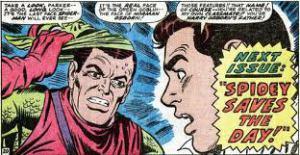
When it came time to do the first Sam Raimi Spider-Man film they couldn’t decide which villain to use: Green Goblin or Doctor Octopus. So, for a brief period early on in development they were going to use both before settling on the Goblin. The point being that it can be difficult to decide for sure who is Spider-Man’s ultimate enemy (the Joker to his Batman, if you will), but the Goblin is always part of the conversation, thanks in no small part to being the one who brought about Gwen Stacy’s death.
However, when he was first introduced in the comics he was a total mystery, which was a trick Stan Lee and Steve Ditko had already done before with a villain trying to take over the New York mob who after multiple issues was revealed to be a colleague of Peter’s from the Daily Bugle. Ditko was okay with having one mysterious villain turn out to be someone Peter knew, but to do so again so soon afterward strained credibility. Instead, Ditko’s plan for the Green Goblin was to introduce Norman as Harry’s father to function as a decoy, the guy you’re supposed to think might be the Goblin. Then Spider-Man would discover the Goblin was someone he didn’t know, a barley-around character associated with J. Jonah Jameson.
Lee, on the other hand, was absolutely adamant that the Goblin turn out to be Norman Osborn because the mystery and build-up could not simply result in a mask being pulled away followed by Spider-Man still wondering, “Who the hell are you?” So, when Ditko quit Lee wasted no time, revealing the Goblin as Norman Osborn in the very first post-Ditko issue.
5. Spider-Man paved the way for the famous Green Arrow/Green Lantern drug special
At some point, comic books had to grow up, and while Marvel was more socially aware (what with the X-Men universe pitting Magneto vs. Professor X, the former preaching like Malcolm X and the latter like Martin Luther King, Jr.) it too was criticized as the 60s wore on for not being progressive enough. To many, the tide really turned with DC’s infamous Green Lantern/Green Arrow story in which the sanctimonious Green Arrow discovers that his sidekick is addicted to heroine.

In a roundabout way, though, that never would have been possible were it not for Spider-Man. In 1971, the US Department of Health, Education, and Welfare asked Stan Lee to create a Amazing Spider-Man story line which addressed drug use, picking Spider-Man since it was among the highest-selling comics in the industry at that time. The problem was the Comics Code Authority, founded to police the comics industry beginning in 1954, forbade any depiction of drug usage, positive or negative. Even Lee’s “But the US government wants us to do this, you idiots” argument wasn’t enough to sway the rather out of touch Comics Code. So, Lee’s only option was to publish without the Comics Code Authority seal of approval, something which had not been done since the Authority began. However, Lee, with the approval of his publisher, risked it, and though you wouldn’t know it from its cover The Amazing Spider-Man #96 depicted Peter Parker discovering best friend Harry Osborn was “a pill-popper!”
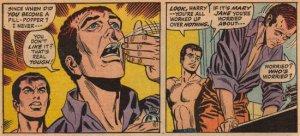
It was such a success that the Comics Code Authority overhauled its guidelines to allow negative depictions of drugs. DC had actually already planned out its Green Lantern/Green Arrow drug issue, but were not as willing to run afoul of the Authority as Stan Lee, thus holding back on publishing. It was only after the guideline changes that they moved forward with their far more vaunted tale of heroine overdose.
6. The black Spider-Man costume that became Venom originated out of a competition for aspiring comic book writers and artists
In 1983, Marvel used The Official Marvel Comics Try-Out Book to invite fans to send in story ideas and drawings. Randy Schueller responded, suggesting a story idea wherein Spider-Man would work with Mr. Fantastic to make his suit stronger than the existing cloth one, and along the way the suit would be re-designed as all-black. Marvel’s editor in chief Jim Shooter liked the idea enough to buy the story from Schueller for $220, even bringing Schueller in to work with an in-house Marvel writer to draft the story together. Unfortunately, it went nowhere.
That is until a year later when Marvel was in the middle of a crossover event called Secret Wars, which featured most of Marvel’s heroes and set out to introduce a few notable changes to most of the characters throughout the story. Shooter remembered Schueller’s idea for a black suit, and that became the change for Spider-Man in Secret Wars, in which he finds the suit, initially unaware that it is actually a living entity.
7. Venom was originally supposed to be female
Now, imagine if instead of Topher Grace as Eddie Brock being taken over by the Venom symbiote that was some random actress giving herself over to the symbiote. That’s pretty much what Venom’s creator, David Michelinie, originally had in mind.
In his original conception, Venom was pretty much identical to what we now know with one crucial difference. A pregnant woman in the middle of being rushed to the hospital by her husband would have her life forever ruined, however inadvertently, by Spider-Man. While hailing a cab to go the hospital, her husband would be run over by a cab driver distracted by the sight of Spider-Man fighting a super villain. The husband would die in front of the woman who would immediately go into labor only to ultimately lose the baby and her sanity. She would be admitted to a mental institution, and upon her release she would be consumed with intense hatred for Spider-Man much as Eddie Brock is filled with hatred for Peter Parker the moment Venom takes over his body. The Amazing Spider-Man editor Jim Salicrup actually had no issue whatsoever with the notion of a major character suffering a miscarriage and watching her husband die in front of her. He simply thought readers wouldn’t buy a female villain, and that Venom needed to occupy a male to make for a formidable physical match for Spider-Man.
8. Spider-Girl was saved from cancellation by a fake letter from a young female fan
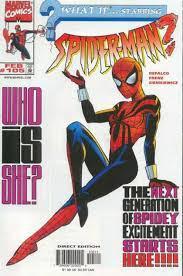
In 1998, Marvel introduced Spider-Girl, Spider-Man’s daughter, as part of series of comics devoted strictly to the sons and daughters of famous Marvel heroes. Spider-Girl was the only one who survived, anchoring her own book for 3 years until Marvel decided to cancel it.
Then Marvel editor-in-chief Joe Quesada received a fan letter from a little girl pleading with him not to cancel Spider-Girl because there were so few superheroes for little girls, and Spider-Girl was her favorite. There were other fans who were writing in at the time with your standard “Save Spider-Girl” petitions, but somehow about the heartfelt nature (and indication of an untapped market/demographic) resonated with Quesada. So, Marvel re-printed the older Spider-Girl stories in a new line aimed at girl readers. Quesada wanted to celebrate the news by arranging a meeting with the girl who wrote the latter, but then he found out there was no little girl at all. The letter had been written by an older male fan from the hypothetical point of view of his infant daughter should she be given the chance to grow up and read Spider-Girl.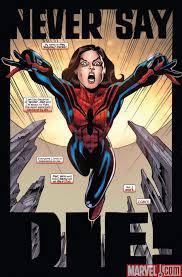
Sources: Brian Cronin’s Was Superman a Spy?: And Other Comic Book Legends Revealed; Sean Howe’s Marvel Comics: The Untold Story, GreenGoblinsHideOut

